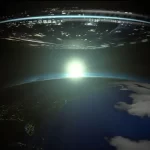Key Takeaways:
- New research suggests that the Big Bang may not have been the beginning of our universe, but rather a consequence of a higher-dimensional black hole’s collapse.
- The conventional view of the Big Bang involves a singularity, a point of infinite density and temperature, which poses significant challenges in understanding its origin.
- Researchers propose that our universe exists as a three-dimensional “wrapping” around a four-dimensional black hole’s event horizon.
- This theory relies on advanced mathematics and holography to transform the Big Bang into a cosmic mirage and offers testable predictions.
- While the concept of a four-dimensional universe may seem perplexing, it challenges our limited three-dimensional perspective on reality.
The origins of our universe have long perplexed scientists, but a groundbreaking theory posits a novel and mathematically sound explanation that has captured the attention of the scientific community.
This intriguing hypothesis suggests that the Big Bang, the cataclysmic event that birthed our universe 13.7 billion years ago, might not have been the absolute beginning. Instead, it may be a consequence of a higher-dimensional black hole’s collapse. This concept challenges our conventional understanding of cosmology and could revolutionize our perception of the universe.
Three researchers from the Perimeter Institute have presented this captivating idea, which has been featured as the cover story in Scientific American under the title “The Black Hole at the Beginning of Time.” Niayesh Afshordi, Robert Mann, and Razieh Pourhasan propose that what we perceive as the Big Bang could be akin to a three-dimensional “mirage” originating from a collapsing star in a vastly different universe.
Traditionally, cosmologists have grappled with the notion of the Big Bang commencing from a singularity—a point in spacetime where the laws of physics break d
own due to unimaginable heat and density. Singularities are enigmatic and defy our understanding. The new theory challenges this paradigm, suggesting that our universe might not have emerged from such a singularity.

The researchers propose an alternative scenario: our known universe might be the three-dimensional “wrapping” around the event horizon of a four-dimensional black hole. In a three-dimensional universe like ours, black holes have two-dimensional event horizons, marking the “point of no return.” However, in a four-dimensional universe, a black hole would possess a three-dimensional event horizon.
According to this model, our universe did not originate within the singularity but rather came into existence beyond the event horizon, shielded from the chaotic singularity. It would essentially be just one facet within the imploded remnants of a four-dimensional star.
While this idea may initially appear “absurd,” it is firmly grounded in cutting-edge mathematics, particularly through the application of holography, which transforms the Big Bang into a cosmic illusion. Notably, this theory also addresses longstanding cosmological puzzles and offers predictions that can be tested.
Admittedly, the notion of our universe emerging from a four-dimensional black hole challenges human intuition, which is rooted in a three-dimensional world. This theory urges us to consider that our reality may only reveal a fraction of a greater, multidimensional truth.
Drawing parallels to Plato’s allegory of the cave, where prisoners perceive only shadows, the researchers suggest that our understanding of the universe may be similarly limited. While we may not comprehend what a four-dimensional universe entails, this theory encourages us to seek answers beyond our familiar three-dimensional perspective.


